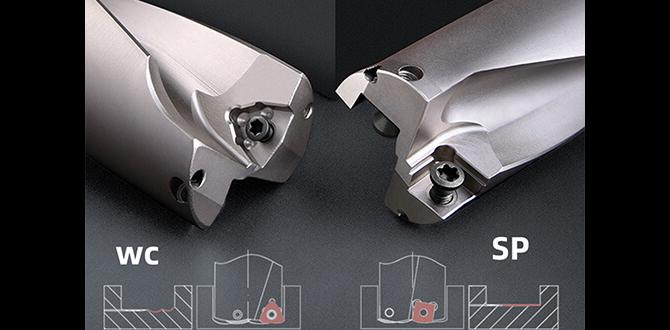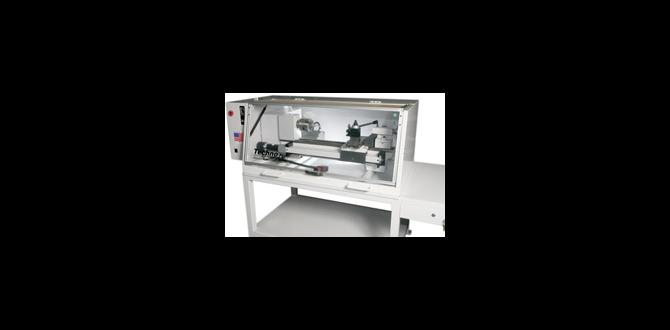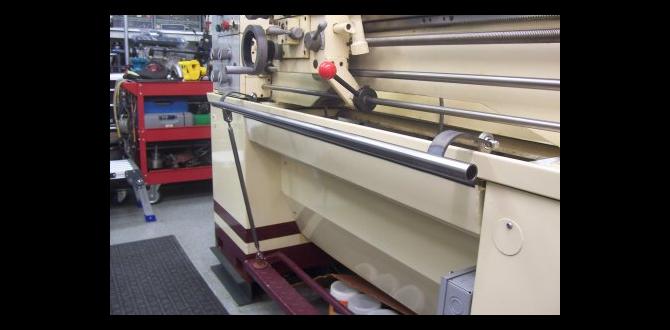Quick Summary:
A mini wood lathe with variable speed is a genius buy for beginners because it offers precise control over cutting speeds, enhancing safety and project quality. This versatility makes tackling various wood types and projects much easier, boosting confidence and creativity in your workshop.
Hey makers, Daniel Bates here from Lathe Hub! Ever feel like you’re wrestling with your wood projects instead of shaping them? Getting the right speed on your lathe can feel like a puzzle, especially when you’re starting out. Too fast, and things can get shaky; too slow, and you’re fighting the wood. But what if there was a tool that made finding that perfect speed simple? Well, there is, and it’s a game-changer. We’re talking about the mini wood lathe with variable speed. It’s not just a piece of equipment; it’s your new best friend for creating beautiful turned projects, safely and smoothly. Stick with me, and I’ll show you why this might be the smartest purchase you make for your workshop.
Why Variable Speed is a Workshop Game-Changer
When you’re just getting into woodworking, every tool choice matters. You want something that helps you learn, grows with you, and doesn’t make the learning curve any steeper than it needs to be. That’s where a mini wood lathe with variable speed truly shines. Unlike older or simpler models that often have fixed speed settings, a variable speed lathe lets you dial in the exact RPM (Revolutions Per Minute) you need for any task. This control is more than just a convenience; it’s fundamental to good woodworking practice and safety.
Think about it: different types of wood have different densities and grains. A soft pine will need a different cutting speed than a hard maple. Larger pieces of wood often require slower speeds than smaller ones to manage forces and prevent vibration. Even the type of operation matters – roughing out a blank is different from fine-tuning a delicate curve. A variable speed lathe allows you to adjust on the fly, ensuring cleaner cuts, less tear-out, and a significantly safer working environment. It’s like having a toolbox full of different lathes, all in one compact machine.
The Benefits of Fine-Tuning Your Speed
Let’s break down why this precise control is so valuable:
- Enhanced Safety: This is paramount for any beginner. Controlling the speed reduces the risk of catching tools, “chatter” (unwanted vibrations), and workpiece ejection. Slower speeds are your ally when you’re learning challenging cuts or working with unstable materials.
- Improved Cut Quality: Every woodworker wants smooth, clean finishes. Variable speed allows you to find the “sweet spot” for your tools and the wood you’re using, minimizing rough surfaces and saving you sanding time later.
- Versatility: You can tackle a wider range of projects and wood types. From small, delicate pens to larger bowls, you can adjust the speed to suit the size, density, and shape of your workpiece.
- Learning Curve Smoother: When you don’t have to fight the machine or worry about it being too fast, you can focus on technique. This accelerates your learning and builds confidence quickly.
- Tool Longevity: Running tools at appropriate speeds helps maintain their sharpness and reduces wear and tear on both the tools and the lathe itself.
Understanding How Variable Speed Works
At its core, variable speed on a mini wood lathe gives you the ability to smoothly change the rotation speed of the headstock (where the wood spins) without needing to change belts between pulleys, as is common on non-variable speed lathes. This is typically achieved through an electronic control system.
Most mini wood lathes with variable speed use one of two main electronic methods:
- DC or AC Motor with Speed Controller: This is the most common setup. The lathe uses a motor that’s electronically managed. A dial or set of buttons on the lathe allows you to adjust the voltage or frequency going to the motor, which in turn changes its RPM. Some higher-end models might have a digital display showing the exact RPM, which is incredibly helpful for consistent results.
- pulley System with Electronic Control: While less common for purely variable speed systems, some lathes might use a system that electronically adjusts the motor’s speed and offers a few belt pulley positions for a wider torque and speed range. You’ll usually find a dial that allows you to fine-tune the speed within each belt position.
The key takeaway is that you get smooth, stepless control. You can turn the dial and go from 200 RPM to, say, 3500 RPM without any clunky steps. This seamless adjustment is what makes it so intuitive and effective.
Comparing Variable Speed vs. Belt Drive Lathes
To really appreciate why variable speed is a “genius buy,” let’s compare it to the alternative: the belt-drive lathe. Many entry-level or older lathes use a system where you have to physically move a belt from one pulley to another to change speed settings. This often involves opening up the lathe’s casing and repositioning the belt.
Here’s a quick look at the differences:
| Feature | Mini Wood Lathe with Variable Speed | Belt Drive Lathe (Fixed Speed Pulleys) |
|---|---|---|
| Speed Adjustment | Smooth, stepless control via electronic dial/buttons. | Limited to a few set speeds, requires manual belt change. |
| Ease of Use | Very easy; adjust speed while the lathe is running (with caution). | Time-consuming; requires stopping the lathe and opening the housing. |
| Versatility | High; ideal for various wood types, sizes, and operations. | Limited; best suited for specific tasks or wood types. |
| Learning Curve | Smoother; focus on technique, not on speed limitations. | Steeper; requires understanding how different speeds affect cuts. |
| Cost | Generally higher initial cost. | Often more affordable. |
| Maintenance/Complexity | Electronic components can be a point of failure, but generally reliable. | Mechanically simpler, but belt wear is a factor. |
For a beginner, the significant difference in ease of use and versatility makes the variable speed option a much more intelligent investment. You’re paying a bit more upfront, but you’re gaining immensely in productivity, learning, and enjoyment.
Key Features to Look For in a Mini Wood Lathe with Variable Speed
When you’re shopping for your first variable speed mini lathe, don’t just check for the “variable speed” label. Here are some other critical features that will make your life easier and your projects better:
- Horsepower (HP): For mini lathes (typically under 18 inches between centers), 1/2 HP to 1 HP is usually sufficient for most beginner projects. More HP means more power to handle larger or denser woods without bogging down.
- Distance Between Centers: This is the maximum length of a workpiece the lathe can accommodate. Common lengths range from 8 to 18 inches. Consider what kinds of projects you envision. For bowls, you’ll be limited by the swing (diameter), but for longer items like pens or spindles, this is key.
- Swing: This refers to the maximum diameter of a workpiece the lathe can turn. It’s measured from the center of the spindle to the nearest part of the lathe bed. A common swing for mini lathes is 10 to 12 inches. This is critical for bowl turning.
- Headstock and Tailstock Taper: Most mini lathes use a Morse Taper (MT). MT1 or MT2 are common. This standard ensures that accessories like drill chucks and live centers fit securely.
- Tool Rest: Look for a sturdy, easily adjustable tool rest that can be positioned at the right height and distance from your workpiece.
- Bed Construction: A heavier, more rigid bed (often cast iron) will absorb vibrations better than a lighter aluminum or steel bed, leading to smoother cuts.
- Rating System: Understand the motor type. DC (Direct Current) motors generally offer better torque at lower speeds compared to AC motors. This is a big plus for roughing down large blanks.
- Included Accessories: Check what comes with the lathe. A spur center, live center, drive center, and a basic faceplate are common. A chuck (for holding smaller turnings securely) might be an optional extra but is highly recommended for pen making and other small items.
Understanding RPM Ranges
The RPM range is crucial for variable speed lathes. You’ll want a lathe that can go both slow and fast.
- Low Speeds (e.g., 200-600 RPM): Essential for roughing out large blanks, turning very soft or punky wood, and when you start a new, unbalanced piece. Low speeds offer more control, reduce vibration, and minimize the risk of “catching” the wood, which can be dangerous.
- Medium Speeds (e.g., 600-1500 RPM): Good for general turning, shaping, and intermediate cuts.
- High Speeds (e.g., 1500-3500 RPM): Ideal for sanding and finishing. The higher speed smooths the wood surface more effectively, especially during sanding. It’s also good for turning smaller, well-balanced pieces.
A lathe with a broad RPM range, like 250-3500 RPM, offers the most flexibility. Always consult reputable sources for recommended speeds based on wood type and project size, such as guides from university extension offices or woodworking associations. For example, the Wood Info Net provides valuable insights into safe turning speeds.
Getting Started: Your First Steps with a Variable Speed Mini Lathe
So you’ve got your new mini wood lathe with variable speed. Exciting! Before you turn it on, let’s go through the basics:
Safety First, Always!
This cannot be stressed enough. Woodworking, especially lathe work, has inherent risks. Always:
- Wear Safety Glasses or a Face Shield: Protect your eyes from flying chips. A full face shield is even better.
- No Loose Clothing, Jewelry, or Long Hair: These can get caught in the rotating workpiece.
- Use Sharp Tools: Dull tools require more force, increase the risk of error, and produce poor results. Learn how to sharpen your gouges and chisels properly.
- Secure Your Workpiece: Make sure the wood is firmly mounted between the centers or in the chuck.
- Stand to the Side: Never stand directly in line with the spinning workpiece.
- Start Slow: Begin at the lowest speed setting, especially when starting a new piece or making a new cut. Gradually increase speed as needed once the workpiece is round and balanced.
- Know Your Emergency Stop: Be prepared to hit the power switch quickly if something goes wrong.
The Occupational Safety and Health Administration (OSHA) has detailed guidelines for woodworking machinery safety that are worth reviewing, even for hobbyist use.
Setting Up Your Lathe
Place your lathe on a sturdy, level workbench. Ensure it’s stable and won’t vibrate excessively. If it has rubber feet, that’s great. If not, consider adding some damping material underneath.
Mounting Your First Piece of Wood
For your very first project: choose a straight piece of soft wood, like pine or poplar, about 6-8 inches long and 3-4 inches in diameter. You’ll be turning it into a simple cylinder.
- Prepare the Wood: If your wood is significantly oversized, you might need to saw off the corners to make it roughly octagonal. This reduces the initial imbalance.
- Insert Centers: Place the spur center (the one with points) into the headstock spindle and the live center (the spinning one) into the tailstock.
- Position the Wood: Place the wood blank between the centers. The spur center should be sunk slightly into the wood on one end, and the tailstock center should be snug against the other end.
- Engage Tailstock: Position the tailstock so it supports the wood. Apply gentle pressure to the tailstock handwheel to advance the live center, seating it firmly against the wood. Do not overtighten; you should be able to turn the wood blank by hand with a little resistance.
- Turn on the Lathe (Lowest Speed!): Start the lathe at its lowest speed setting.
- Check for Wobble: Observe how the workpiece spins. If it wobbles excessively, stop the lathe immediately, relieve tailstock pressure slightly, and reseat the live center.
Basic Turning Technique
Once the wood is spinning reasonably smoothly at a low speed:
- Position the Tool Rest: Adjust the tool rest so it’s about 1/8 inch away from the wood and slightly below the center line of the workpiece.
- Grip Your Tool: Use a basic spindle gouge or a skew chisel. Hold it firmly with both hands.
- Start Roughing: At the lowest speed, gently engage the tool with the spinning wood. Aim to remove the high corners and start creating a cylinder. Keep your cuts light and controlled.
- Gradually Increase Speed: As the wood becomes more round, you can slowly increase the lathe’s speed. Listen to the machine and feel for vibrations. If it starts to chatter, slow down.
- Shape and Refine: Continue making light cuts, shaping the cylinder. Practice moving the tool smoothly along the workpiece.
- Sanding: Once you have a basic shape, increase the speed to its higher range for sanding. Start with a coarser grit sandpaper (like 120) and move to finer grits (220, 320, etc.). Sand with the grain.
Learning to read the wood and listen to your machine is part of the process. Don’t be afraid to stop, reassess, and start again. Patience is a woodturner’s best friend.
Projects Perfect for Your Mini Variable Speed Lathe
The beauty of a variable speed mini lathe is its ability to handle a surprising variety of projects, making it incredibly versatile for a home workshop. Here are some popular and achievable projects for beginners:
1. Pens and Pencils
This is a classic beginner project. They are small, quick to turn, and use minimal material. The variable speed is crucial for the detail work and for sanding these small items smoothly.
Why it’s great:
- Uses small wood scraps.
- Requires a pen kit (readily available online or at hobby stores).
- Teaches precise control and smooth finishes.
- Results in practical, giftable items.
2. Small Bowls and Spoons
With a decent swing capacity (10 inches or more), you can turn small to medium-sized bowls. A good chuck is highly recommended for bowl turning to securely hold the piece during the complex shaping and hollowing process.
Why it’s great:
- Develops skills in hollowing and shaping curves.
- Teaches workholding techniques (using a chuck).
- Produces functional and decorative items.
- Variable speed is useful for roughing (slow) and finishing (medium-high).
3. Spindles and Tapered Legs
Turn simple cylinders, spindles for decorative pieces, or legs for small tables or chairs. This project hones your ability to create straight, parallel, or uniformly tapered forms.
Why it’s great:
- Excellent for practicing tool control and creating smooth surfaces.
- Teaches how to maintain consistent diameter and shape.
- Requires less complex setups than bowl turning.
4. Dust Plugs and Feet
Even simple items like screw-in feet for furniture or decorative plugs can be turned. These are quick projects that let you practice basic turning and fitting.
Why it’s great:
- Very easy and fast to complete.
- Good for practicing basic cylinder and plug shapes.
- Useful for small workshop repairs or enhancements.
5. Toy Tops
A fun, classic project that’s both enjoyable to make and to play with! Turning a well-balanced top requires attention to detail and smooth shaping.
Why it’s great:
- Teaches attention to balance and smooth curves.




